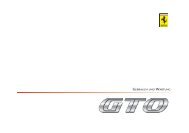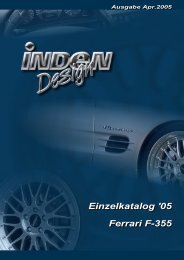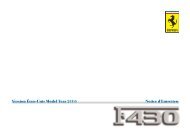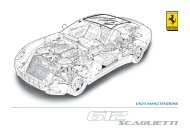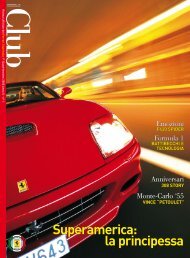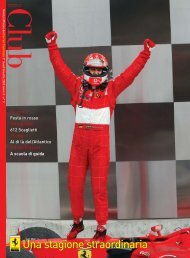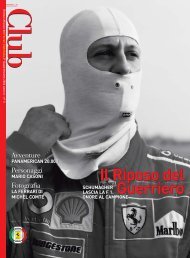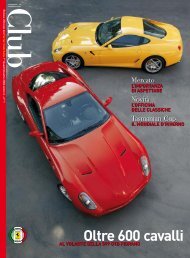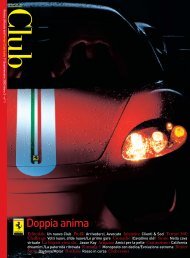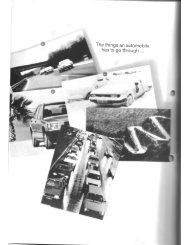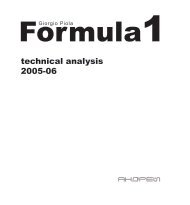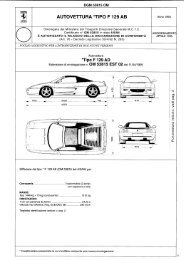360 Modena gear box manual - All Ferraris
360 Modena gear box manual - All Ferraris
360 Modena gear box manual - All Ferraris
You also want an ePaper? Increase the reach of your titles
YUMPU automatically turns print PDFs into web optimized ePapers that Google loves.
The two levers, fitted behind the steering wheel, control <strong>gear</strong> UP-shifting (1) or DOWN-shifting (2).<br />
Through lever (4), placed on the central tunnel panel, the reverse <strong>gear</strong> is engaged; the AUTO mode<br />
is activated through switch (5) and a second switch (6) activates the LOW GRIP mode. An "on-off"<br />
switch, placed on the lateral pannel ( H 2.03), activates the SPORT mode ( G 4.01 ) and<br />
F 4.04). The latter is not connected to a TCU input: the control unit receives data concerning<br />
the instrument panel switch status through the CAN line.<br />
• Informs the driver of the system's status, through visual and acoustic signals.<br />
On the instrument panel there are: a display on which the engaged <strong>gear</strong> is indicated, two warning<br />
lights that indicate if AUTO and LOW GRIP modes are active, a third warning light indicating system<br />
failures. Moreover, an acoustic alarm indicates the presence of anomalies or an incorrect<br />
manoeuvre by the driver. The SPORT mode is indicated by a warning light also placed on the<br />
instrument panel but which is shared by the suspensions ECU.<br />
• Checks the hydraulic actuators.<br />
The comands sent by the ECUs are actuated by a hydraulic system composed of a Power Unit (9)<br />
and of actuators for <strong>gear</strong> engagement and selection (8) and for clutch movement.<br />
• Detects the position of the three hydraulic actuators.<br />
A position sensor has been fitted on each of the hydraulic actuators for the <strong>gear</strong><strong>box</strong> and clutch<br />
control.<br />
• Detects the angular engine speed.<br />
Above the rear part of the <strong>gear</strong><strong>box</strong>, there is a sensor ( D 6.08) for the detection of speed at<br />
<strong>gear</strong> shifting.<br />
• Detect special car conditions.<br />
Through apposite sensors and switches, the system can detect any intervention carried out on the<br />
foot brake pedal (3), on the engine compartment lid and on the driver side door.<br />
• Interface with the engine control system.<br />
This is a very important connection, since during <strong>gear</strong> shifting the EMS (Engine Monitoring System)<br />
turns into a torque generator interfaced with the <strong>gear</strong><strong>box</strong>. The EMS, moreover, can communicate to<br />
the transmission system some useful data, therefore avoiding duplicating sensors on the vehicle..<br />
• Please read all information provided on ECUs that communicate through the CAN line.<br />
Working Strategies<br />
In order to better understand the clutch control strategies, you must consider two working<br />
conditions: pickup (during start up) and <strong>gear</strong> shifting.<br />
When picking up, the engine is idle and the car is stationary.<br />
The driver, wanting to start the car, presses the accelerator pedal. As a consequence of this, the<br />
engine speed increases. In order to avoid excessive rpm, the clutch must close progressively with a



